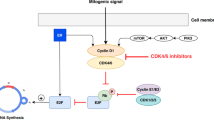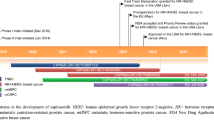Abstract
Purpose: This study assessed the cytotoxic effects of irofulven in combination with oxaliplatin and cisplatin in a panel of human cancer cell lines. Methods: Growth inhibition studies were performed using the human HT29 colon cancer cell line, irofulven-resistant derivative HT29/IF2, breast cancer cell line MCF7, and ovarian cancer line CAOV3. Irofulven–oxaliplatin combinations were compared with irofulven–cisplatin combinations in the same cell lines using similar experimental settings. Cells were exposed for 1 h to irofulven and then for 24 h to oxaliplatin or cisplatin and vice versa. Results: Single agent irofulven displayed cytotoxic effects against human colon HT29 cells, human breast cancer cell lines including MCF7, SKBR3, and ZR-75-1, and human ovarian cancer cell lines CAOV3, OVCAR3, and IGROV1, with OVCAR3 being the most sensitive cancer cell line (IC50: 2.4 μM). In all tested cell lines the oxaliplatin–irofulven combination led to clear evidence of synergistic activity. In HT29 and HT29/IF2, the sequence oxaliplatin followed by irofulven appears to be the most effective whereas in MCF7 cells, irofulven given prior to or simultaneously with oxaliplatin is more effective than the other schedule. The combination displays additive activity toward CAOV3 ovarian cells when irofulven was administered prior to or simultaneously with oxaliplatin and partially synergistic when oxaliplatin was followed by irofulven. In most of the cell lines, the sequence oxaliplatin followed by irofulven appears to be the most effective as compared to other schedules. A combination of irofulven with cisplatin has the same efficacy as with oxaliplatin for the same cell lines. Cell cycle studies show that irofulven increases the proportion of cells in the S phase. Cisplatin–irofulven and oxaliplatin–irofulven combinations block cells in G1/S and potently induce apoptosis. Conclusion: Irofulven displays synergistic antiproliferative and pro-apoptotic effects when combined with oxaliplatin over a broad range of concentrations in human colon and breast cancer cells. Acquired resistance to irofulven has limited impact on the effects of cisplatin–irofulven and oxaliplatin–irofulven combinations. Based on these data, irofulven–oxaliplatin and cisplatin–irofulven combinations will be further explored in clinical trials, favoring the use schedules of oxaliplatin given prior to irofulven in patients with cancer.







Similar content being viewed by others
References
Woynarowski JM, Napier C, Koester SK, Chen SF, Troyer D, Chapman W, MacDonald JR (1997) Effects on DNA integrity and apoptosis induction by a novel antitumor sesquiterpene drug, 6-hydroxymethylacylfulvene (HMAF, MGI 114). Biochem Pharmacol 54:1181–1193
Woynarowska BA, Woynarowski JM, Herzig MC, Roberts K, Higdon AL, MacDonald JR (2000) Differential cytotoxicity and induction of apoptosis in tumor and normal cells by hydroxymethylacylfulvene (HMAF). Biochem Pharmacol 59:1217–1226
Poindessous V, Koeppel F, Raymond E, Comisso M, Waters SJ, Larsen AK (2003) Marked activity of irofulven toward human carcinoma cells: comparison with cisplatin and ecteinascidin. Clin Cancer Res 9:2817–2825
Jaspers NG, Raams A, Kelner MJ, Ng JM, Yamashita YM, Takeda S, McMorris TC, Hoeijmakers JH (2002) Anti-tumour compounds illudin S and Irofulven induce DNA lesions ignored by global repair and exclusively processed by transcription- and replication-coupled repair pathways. DNA Repair (Amst) 1(12):1027–1038
Koeppel F, Poindessous V, Lazar V, Raymond E, Sarasin A, Larsen AK (2004) Irofulven cytotoxicity depends on transcription-coupled nucleotide excision repair and is correlated with XPG expression in solid tumor cells. Clin Cancer Res 10:5604–5613
Wang J, Wiltshire T, Wang Y, Mikell C, Burks J, Cunningham C, Van Laar ES, Waters SJ, Reed E, Wang W (2004) ATM-dependent CHK2 activation induced by anticanceragent, irofulven. J Biol Chem 279:39584–39592
Herzig MC, Liang H, Johnson AE, Woynarowska B, Woynarowski JM (2002) Irofulven induces apoptosis in breast cancer cells regardless of caspase-3 status. Breast Cancer Res Treat 71:133–143
Herzig MC, Trevino AV, Liang H, Salinas R, Waters SJ, MacDonald JR, Woynarowska BA, Woynarowski JM (2003) Apoptosis induction by the dual-action DNA-and protein-reactive antitumor drug irofulven is largely Bcl-2-independent. Biochem Pharmacol 65:503–513
Wang W, Waters SJ, MacDonald JR, Roth C, Shentu S, Freeman J, Von Hoff DD, Miller AR (2002) Irofulven (6-hydroxymethylacylfulvene, MGI 114)-induced apoptosis in human pancreatic cancer cells is mediated by ERK and JNK kinases. Anticancer Res 22:559–564
Britten CD, Hilsenbeck SG, Eckhardt SG, Marty J, Mangold G, MacDonald JR, Rowinsky EK, Von Hoff DD, Weitman S (1999) Enhanced antitumor activity of 6-hydroxymethylacylfulvene in combination with irinotecan and 5-fluorouracil in the HT29 human colon tumor xenograft model. Cancer Res 59:1049–1053
Hammond LA, Hilsenbeck SG, Eckhardt SG, Marty J, Mangold G, MacDonald JR, Rowinsky EK, Von Hoff DD, Weitman S (2000) Enhanced antitumour activity of 6-hydroxymethylacylfulvene in combination with topotecan or paclitaxel in the MV522 lung carcinoma xenograft model. Eur J Cancer 36:2430–2436
Kelner MJ, McMorris TC, Rojas RJ, Trani NA, Velasco TR, Estes LA, Suthipinijtham P (2002) Enhanced antitumor activity of irofulven in combination with antimitotic agents. Invest New Drugs 20:271–279
Woo MH, Peterson JK, Billups C, Liang H, Bjornsti MA, Houghton PJ (2004) Enhanced antitumor activity of irofulven in combination with irinotecan in pediatric solid tumor xenograft models. Cancer Chemother Pharmacol [Epub ahead of print]
Andre T, Boni C, Mounedji-Boudiaf L, Navarro M, Tabernero J, Hickish T, Topham C, Zaninelli M, Clingan P, Bridgewater J, Tabah-Fisch I, de Gramont A (2004) Oxaliplatin, fluorouracil, and leucovorin as adjuvant treatment for colon cancer. N Engl J Med 350:2343–2351
Arnould S, Hennebelle I, Canal P, Bugat R, Guichard S (2003) Cellular determinants of oxaliplatin sensitivity in colon cancer cell lines. Eur J Cancer 39:112–119
Raymond E, Chaney S, Taamma K, Cvitkovic E (1998) Oxaliplatin: a review of preclinical and clinical studies. Ann Oncol 9(10):1053–1071
Nehme A, Baskaran R, Nebel S, Fink D, Howell SB, Wang JY, Christen RD (1999) Induction of JNK and c-Abl signaling by cisplatin and oxaliplatin in mismatch repair-proficient and-deficient cells. Br J Cancer 79:1104–1110
Raymond E, Faivre S, Chaney S, Woynarowski J, Cvitkovic E (2002) Cellular and molecular pharmacology of oxaliplatin. Mol Cancer Ther 1:227–235
Eckhardt SG, Baker SD, Britten CD, Hidalgo M, Siu L, Hammond LA, Villalona-Calero MA, Felton S, Drengler R, Kuhn JG, Clark GM, Smith SL, MacDonald JR, Smith C, Moczygemba J, Weitman S, Von Hoff DD, Rowinsky EK (2000) Phase I and pharmacokinetic study of irofulven, a novel mushroom-derived cytotoxin, administered for five consecutive days every 4 weeks in patients with advanced solid malignancies. J Clin Oncol 18(24):4086–4097
Sarosy GA, Kotz H, Smith S et al (2001) Phase II study of irofulven in platinum resistant recurrent ovarian cancer. Proc Am Soc Clin Oncol 20:218a
Tombal B, Tourani JM, Fizzazi K et al (2003) Randomized phase II trial of irofulven (IROF) with or without prednisone in hormone-refractory prostate cancer (HRPC) patients (pts). Proc Am Soc Clin Oncol 22:407
Alexandre J, Raymond E, Ould Kaci M et al (2004) Phase I and pharmacokinetic study of irofulven administered weekly or biweekly in patients with advanced malignancies. Clin Cancer Res 10(10):3377–3385
Raymond E, Kahatt C, Rigolet MH et al (2004) Characterization and multiparameter analysis of visual adverse events in irofulven single-agent phase I and II trials. Clin Cancer Res 10(22):7566–7574
Urien S, Alexandre J, Raymond E, Brain E, Smith S, Shah A, Cvitkovic E, Lokiec F (2003) Phase I population pharmacokinetics of irofulven. Anticancer Drugs 14:353–358
Raymond E, Buquet-Fagot C, Djelloul S, Mester J, Cvitkovic E, Allain P, Louvet C, Gespach C (1997) Antitumor activity of oxaliplatin in combination with 5-fluorouracil and the thymidylate synthase inhibitor AG337 in human colon, breast and ovarian cancers. Anticancer Drugs 8:876–885
Faivre S, Chan D, Salinas R, Woynarowska B, Woynarowski JM (2003) DNA strand breaks and apoptosis induced by oxaliplatin in cancer cells. Biochem Pharmacol 66:225–237
Van Laar ES, Weitman S, MacDonald JR, Waters SJ (2004) Antitumor activity of irofulven monotherapy and in combination with mitoxantrone or docetaxel against human prostate cancer models. Prostate 59:22–32
Zeghari-Squalli N, Raymond E, Cvitkovic E, Goldwasser F (1999) Cellular pharmacology of the combination of the DNA topoisomerase I inhibitor SN-38 and the diaminocyclohexane platinum derivative oxaliplatin. Clin Cancer Res 5(5):1189–1196
Faivre S, Raymond E, Woynarowski JM, Cvitkovic E (1999) Supraadditive effect of 2′,2′-difluorodeoxycytidine (gemcitabine) in combination with oxaliplatin in human cancer cell lines. Cancer Chem Pharmacol 44(2):117–123
Poindessous V, Koeppel F, Raymond E, Cvitkovic E, Waters SJ, Larsen AK (2003) Enhanced antitumor activity of irofulven in combination with 5-fluorouracil and cisplatin in human colon and ovarian carcinoma cells. Int J Oncol 23:1347–1355
Author information
Authors and Affiliations
Corresponding author
Rights and permissions
About this article
Cite this article
Serova, M., Calvo, F., Lokiec, F. et al. Characterizations of irofulven cytotoxicity in combination with cisplatin and oxaliplatin in human colon, breast, and ovarian cancer cells. Cancer Chemother Pharmacol 57, 491–499 (2006). https://doi.org/10.1007/s00280-005-0063-y
Received:
Accepted:
Published:
Issue Date:
DOI: https://doi.org/10.1007/s00280-005-0063-y




